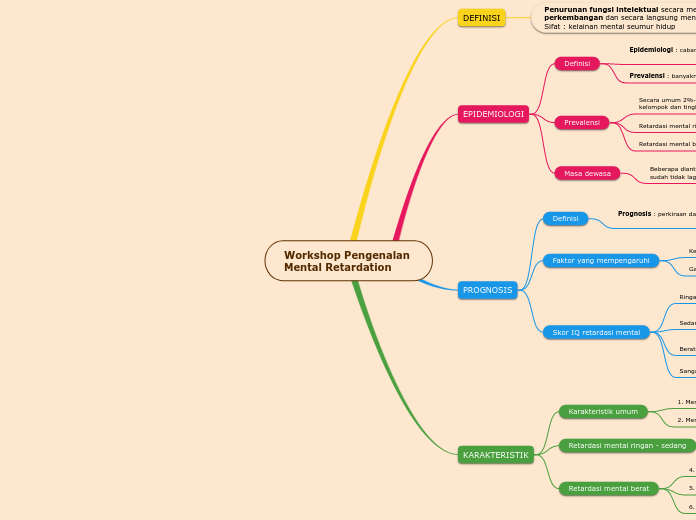av Francisca Novita 4 år siden
604
Workshop Pengenalan Mental Retardation

av Francisca Novita 4 år siden
604

Mer som dette

To name your story, you have to think about the overall message and what you want your audience to understand from the story. Also, make it relevant and easy to remember.
Membenturkan kepala, menggigit diri sendiri, dsb
Mirip dengan yang terlihat pada anak autisme
Karena ketidakmampuan anak memahami arahan verbal
Contoh : keterlambatan bicara
The ending of a story is essential. We all know that if the ending is weak, what happened before loses its importance. So make it unpredictable, but fair. A resolved ending answers all the questions and ties up any loose threads from the plot.
IQ : <25
IQ : 25-39
Membaca untuk bertahan hidup (tanda berhenti / keluar), butuh bantuan dalam kehidupan sehari-hari sehingga harapan hidup dapat menurun secara signifikan.
IQ : 40-54
Dapat belajar dengan kecepatan 1/3 - 1/2, mencapai tingkat membaca kelas 1-3. Jarang ada yang menikah dan memiliki anak, jika ya kemungkinan membutuhkan dukungan dan perawatan kontinyu
IQ : 55-69
Tanpa komorbid : dapat belajar dengan kecepatan normal, 1/2 - 2/3, dan mencapai tingkat membaca kelas 3-6. Pada masa remaja akhir dapat mandiri, menikah, dan memiliki anak.
This is the closure section of the story.
See examples of possible outcomes below:
Try answering these questions in order for you to come up with a closure:
- Have all problems been solved?
- Is it clear what happens with all your characters in the story?
- Has the challenged transformed your main character?
- How do the characters feel in the end?
Try answering these questions to come up with a closure:
- Have all the problems been solved?
- Is there a clear picture of what happens with each character in the story?
- Has the challenge transformed your main character?
- How do the characters feel in the end?
This is the moment when the main character surpasses the last obstacle and finally faces their greatest challenge.
The climax usually follows one of these patterns:
Type in your answer.
Mudah dideteksi pada anak dengan sindrom genetik
Susah dideteksi pada anak usia dini
The middle of the story is where you add layers of complications that will lead to the end. Reveal more about the character's journey. Did their personality go through changes? How did they overcome the challenges? And as you build up the story’s central conflict, make it more personal to that character. Also, from the middle act, you have to lead into the final act.
Saat dewasa, tuntutan kemampuan akademis menurun, sehingga lebih condong ke kegiatan praktik yang bergantung pada kemampuan adaptasi, sehingga berbaur didalam dan bersama dengan orang lain dan keterbelakangan itu tampak lebur.
Each story has a main character and that character usually needs to solve a problem or challenge. The character's challenge is the one that creates tension throughout the story.
Type in any other challenges which other characters in the story need to face.
In most stories, there are 3 challenges. The number 3 is a mystical number symbolizing completeness. Try to come up with interesting challenges with which your character needs to struggle.
See a few examples below:
In the beginning of the story (or the exposition), you will need to introduce the setting and characters. You might also want to introduce the main conflict. This part of the story is important because it gives the reader necessary background information and maybe even a first insight into a character’s personality.
The setting (time & place) of a story can change throughout the plot.